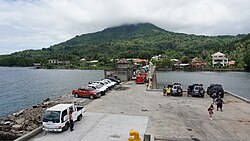Guinsiliban
Appearance
Guinsiliban | |
|---|---|
| Municipality of Guinsiliban | |
 Guinsiliban Port | |
 Map of Camiguin with Guinsiliban highlighted | |
Location within the Philippines | |
| Coordinates: 9°05′53″N 124°47′10″E / 9.098°N 124.786°E | |
| Country | Philippines |
| Region | Northern Mindanao |
| Province | Camiguin |
| District | Lone district |
| Founded | June 13, 1950 |
| Barangays | 7 (see Barangays) |
| Government | |
| • Type | Sangguniang Bayan |
| • Mayor | Helenio N. Abecia (PDPLBN) |
| • Vice Mayor | Elvis O. Roxas (PDPLBN) |
| • Representative | Jurdin Jesus M. Romualdo |
| • Municipal Council | Members |
| • Electorate | 5,395 voters (2022) |
| Area | |
• Total | 18.52 km2 (7.15 sq mi) |
| Highest elevation | 676 m (2,218 ft) |
| Lowest elevation | 0 m (0 ft) |
| Population (2020 census)[3] | |
• Total | 6,685 |
| • Density | 360/km2 (930/sq mi) |
| • Households | 1,707 |
| Economy | |
| • Income class | 6th municipal income class |
| • Poverty incidence | 28.07 |
| • Revenue | ₱ 54.72 million (2020) |
| • Assets | ₱ 99.3 million (2020) |
| • Expenditure | ₱ 48.37 million (2020) |
| • Liabilities | ₱ 25.71 million (2020) |
| Service provider | |
| • Electricity | Camiguin Electric Cooperative (CAMELCO) |
| Time zone | UTC+8 (PST) |
| ZIP code | 9102 |
| PSGC | |
| IDD : area code | +63 (0)88 |
| Native languages | Kinamigin Cebuano Tagalog |
| Website | www |
Guinsiliban, officially the Municipality of Guinsiliban, is a 6th class municipality in the province of Camiguin, Philippines. According to the 2020 census, it has a population of 6,685 people, making it the least populated town in the province.[3]
Geography
[edit]Barangays
[edit]Guinsiliban is politically subdivided into 7 barangays. Each barangay consists of puroks while some have sitios.
- Butay
- Cabuan
- Cantaan
- Liong
- Maac
- North Poblacion
- South Poblacion
Climate
[edit]| Climate data for Guinsiliban, Camiguin | |||||||||||||
|---|---|---|---|---|---|---|---|---|---|---|---|---|---|
| Month | Jan | Feb | Mar | Apr | May | Jun | Jul | Aug | Sep | Oct | Nov | Dec | Year |
| Mean daily maximum °C (°F) | 28 (82) |
28 (82) |
29 (84) |
30 (86) |
30 (86) |
29 (84) |
29 (84) |
30 (86) |
30 (86) |
29 (84) |
29 (84) |
28 (82) |
29 (84) |
| Mean daily minimum °C (°F) | 23 (73) |
23 (73) |
23 (73) |
23 (73) |
24 (75) |
25 (77) |
25 (77) |
25 (77) |
25 (77) |
25 (77) |
24 (75) |
24 (75) |
24 (75) |
| Average precipitation mm (inches) | 327 (12.9) |
254 (10.0) |
185 (7.3) |
128 (5.0) |
215 (8.5) |
273 (10.7) |
248 (9.8) |
243 (9.6) |
214 (8.4) |
246 (9.7) |
271 (10.7) |
271 (10.7) |
2,875 (113.3) |
| Average rainy days | 24.3 | 21.1 | 22.5 | 20.6 | 28.3 | 28.8 | 29.4 | 29.0 | 28.0 | 28.3 | 26.0 | 24.2 | 310.5 |
| Source: Meteoblue[5] | |||||||||||||
Demographics
[edit]| Year | Pop. | ±% p.a. |
|---|---|---|
| 1960 | 3,499 | — |
| 1970 | 5,686 | +4.97% |
| 1975 | 4,057 | −6.55% |
| 1980 | 4,254 | +0.95% |
| 1990 | 4,341 | +0.20% |
| 1995 | 4,919 | +2.37% |
| 2000 | 5,092 | +0.74% |
| 2007 | 5,559 | +1.22% |
| 2010 | 5,580 | +0.14% |
| 2015 | 6,281 | +2.28% |
| 2020 | 6,685 | +1.23% |
| Source: Philippine Statistics Authority[6][7][8][9] | ||
In the 2020 census, the population of Guinsiliban was 6,685 people,[3] with a density of 360 inhabitants per square kilometre or 930 inhabitants per square mile.
References
[edit]- ^ Municipality of Guinsiliban | (DILG)
- ^ "2015 Census of Population, Report No. 3 – Population, Land Area, and Population Density" (PDF). Philippine Statistics Authority. Quezon City, Philippines. August 2016. ISSN 0117-1453. Archived (PDF) from the original on May 25, 2021. Retrieved July 16, 2021.
- ^ a b c Census of Population (2020). "Region X (Northern Mindanao)". Total Population by Province, City, Municipality and Barangay. Philippine Statistics Authority. Retrieved 8 July 2021.
- ^ "PSA Releases the 2021 City and Municipal Level Poverty Estimates". Philippine Statistics Authority. 2 April 2024. Retrieved 28 April 2024.
- ^ "Guinsiliban: Average Temperatures and Rainfall". Meteoblue. Retrieved 4 March 2020.
- ^ Census of Population (2015). "Region X (Northern Mindanao)". Total Population by Province, City, Municipality and Barangay. Philippine Statistics Authority. Retrieved 20 June 2016.
- ^ Census of Population and Housing (2010). "Region X (Northern Mindanao)" (PDF). Total Population by Province, City, Municipality and Barangay. National Statistics Office. Retrieved 29 June 2016.
- ^ Censuses of Population (1903–2007). "Region X (Northern Mindanao)". Table 1. Population Enumerated in Various Censuses by Province/Highly Urbanized City: 1903 to 2007. National Statistics Office.
- ^ "Province of". Municipality Population Data. Local Water Utilities Administration Research Division. Retrieved 17 December 2016.
External links
[edit]



